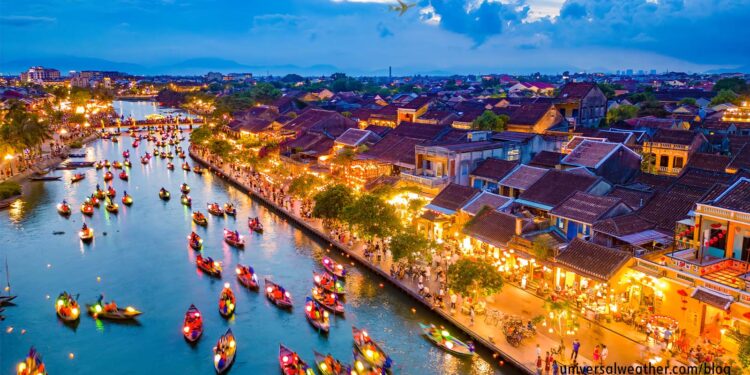Business Aviation in Vietnam – Part 2: CIQ, Documentation, and Ground Services

This is a post by author Edmond Yuen. Edmond is head of Trip Support Services, Asia-Pacific, for Universal Weather and Aviation, Inc., located in Hong Kong. Edmond is an expert on business aircraft operations in Asia and can be contacted at edmondyuen@univ-wea.com.
This business aviation blog post continues from our article last week, entitled “Business Aviation in Vietnam: Part 1 – Operational Tips.”
For business aircraft operators with missions to Vietnam, it’s important to coordinate visa and Customs, Immigration, and Quarantine (CIQ) arrangements and additional ground services with your 3rd-party provider and ground handler in advance.
The following is an overview of what you need to know when operating to Vietnam:
1. Visas are needed for crew and passengers
Crew/passenger visas are needed on arrival for Vietnam at Tan Son Nhat Intl (VVTS), Ha Noi (VVNB), Danang (VVDN), Hue (VVPB), and Cam Ranh (VVCR), which serves the world-class beach resort of Nha Trang. These are all airports of entry. Note that prior arrangements must be made to secure visas on arrival, and lead time for this service is typically two to three business days. It’s important to forward all passport information to your handler in advance and to bring a passport-sized photo on arrival. Passports should have at least six months’ remaining validity at the time of your visa request.
2. Clearing CIQ in Vietnam
In most cases, unless you’ve pre-arranged a VIP room, crew members and passengers clear CIQ within the main terminal along with commercial airline passengers. VIP rooms may be requested for CIQ clearance at VVTS, VVNB, and VVDN. There are extra charges for this service, but it’s well worth the expense to avoid having to clear in the main terminal. When VIP rooms have been arranged, passengers will be transported to this location, passports will be collected, and passengers will wait for their stamped passports to be returned by the ground handler. For crew CIQ clearance, the ground handler will collect crew passports and will take steps to clear them while the crew members are shutting down the aircraft. For departure crew members can go directly to the aircraft while the ground handler takes their passports and clears them outbound.
3. Additional considerations for visas on arrival
Note that passengers/crew must go to the main terminal to process visas on arrival unless they’ve requested a VIP room in advance. Passengers will be escorted to the terminal to fill out a form, attach a passport-sized photo, and provide a visa approval letter for the Vietnam Immigration Department. They will then wait for immigration police to call their names, pay visa stamp fees, and receive their passports with paper visas attached. If passengers have requested VIP lounge service, they’ll simply provide both the passports and passport-sized photos and wait in the lounge while the ground handler obtains the visas.
4. Full services are available
Full aircraft and ground handling services are available at VVTS, VVNB, VVDN, VVCR, and VVPB. Credit for all services and government fees can be arranged with prior notice.
5. In-flight catering options
Crews generally source catering directly from local restaurants and hotels while in Vietnam. Be sure that the hotel/restaurant is aware of packaging requirements for your particular galley configuration and that food items have been cooled to food-safe temperatures prior to pickup. It’s easy and straightforward for crews to transport catering to their aircraft in Vietnam. You’ll normally be permitted to drive right up to your aircraft, after passing through an airport security gate.
6. Local area considerations
Good selections of 4- and 5-star crew hotel accommodations, including large international chain hotels, are available at major destinations in Vietnam. Hotel standards are very high in Vietnam these days, and crew rooms generally run less than $200 per night. Best option for local travel is prepaid transportation (car with driver). Avoid rental cars/scooters and local taxis. Although Vietnam is generally a low-crime environment, pickpocket activity can be a concern – especially in major cities and tourist areas.
7. Additional tips for Vietnam
Two copies of your general declaration are required when you land in Vietnam. The departure port, just prior to your first landing in Vietnam, should prepare these gen decs as authorities will know actual crew, passenger, and cargo specifics. In the case that these gen decs are missing, your ground handler can create them for you upon arrival. When you are in Vietnam, your ground handler will be able to file your flight plan with air traffic control – avoiding the need for the crew to go to the tower. Ramp access for crew transportation is available for arrival/departure. Major airports in Vietnam are secure facilities, with regular patrols and surveillance. Private security can be arranged for your aircraft, but this is generally not recommended at larger airport destinations.
Closing thoughts
It’s always best to try to plan on seven days’ advance notice when arranging services for Vietnam. Ensure that crew/passenger visa arrangements are in place and take the time to source the best ground handler for your intended destination. It’s important to have a ground handler that can orchestrate all required services. Also note that when operating to secondary domestic airfields in Vietnam, there may be additional suggested pre-planning measures.
Questions?
If you have any questions about this article or planning your next trip to Vietnam, contact me at edmondyuen@univ-wea.com.




